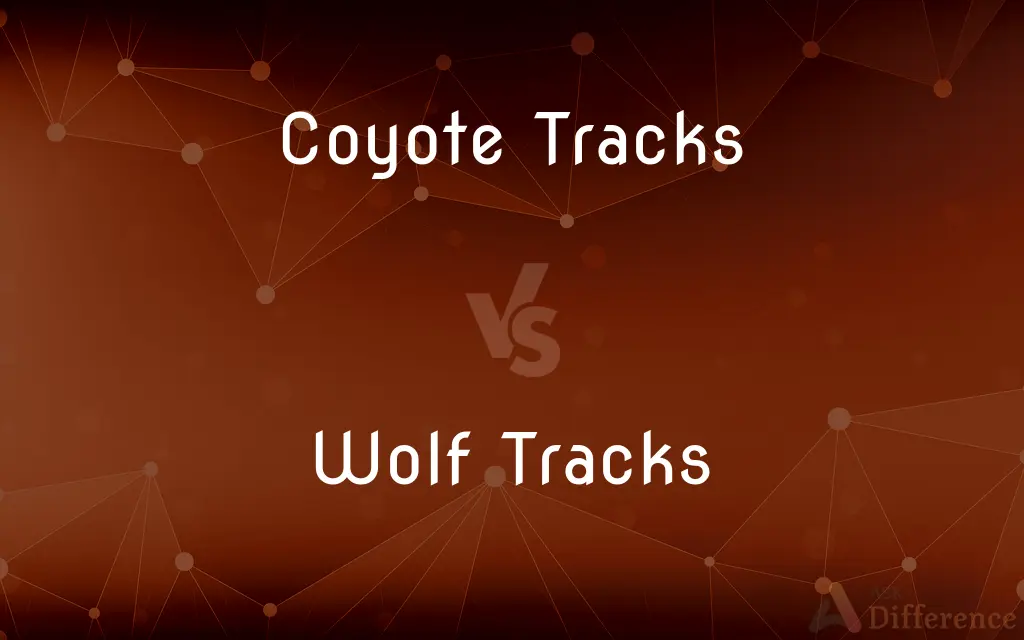Coyote Tracks vs. Wolf Tracks — What's the Difference?
By Tayyaba Rehman & Fiza Rafique — Published on February 29, 2024
Coyote tracks are smaller and more oval, with less space between toes and pads than wolf tracks, which are larger, broader, and more robust, indicating their size difference.

Difference Between Coyote Tracks and Wolf Tracks
Table of Contents
ADVERTISEMENT
Key Differences
Coyote tracks typically measure 2.5 inches in length and are more oval-shaped, reflecting their lighter, more nimble build. In contrast, wolf tracks can be significantly larger, often exceeding 4 inches, showcasing their status as the largest members of the canid family. This size difference is a key indicator of the animal's overall size and strength.
The spacing between the toes and the pad in coyote tracks is less pronounced, with tracks appearing more compact. Wolves, however, leave tracks with a more pronounced separation, indicative of their larger feet and the need to support a heavier body weight. This characteristic can be crucial for differentiating between the two in the wild.
Coyote tracks often show less prominent claw marks due to their lighter tread and the environments they traverse. Wolf tracks, conversely, often display clearer, more pronounced claw marks, a testament to their powerful grip and the rugged terrains they inhabit.
The pattern of movement can also be a distinguishing factor. Coyotes tend to move in a more erratic pattern, with tracks appearing more staggered. Wolves move with purpose and efficiency, often in a straight line, which is reflected in their track patterns.
In snow or mud, the depth of the tracks can further differentiate the two. Coyotes, being lighter, leave shallower impressions than wolves, whose tracks are deeper due to their greater weight. This depth can offer insights into the animal's mass and the force it exerts with each step.
ADVERTISEMENT
Comparison Chart
Size
2.5 inches long, more oval
Over 4 inches long, broader
Toe-Pad Spacing
Less space, more compact
More pronounced separation
Claw Marks
Less prominent, lighter tread
Clearer, due to powerful grip
Movement Pattern
Erratic, staggered
Straight, purposeful
Track Depth
Shallower, due to lighter weight
Deeper, reflecting greater weight
Compare with Definitions
Coyote Tracks
These tracks can indicate an erratic movement pattern.
The coyote tracks zigzagged across the field.
Wolf Tracks
They feature a clear separation between toes and pads.
Each wolf track showed a distinct gap between the toes and the pad.
Coyote Tracks
The depth of coyote tracks can be shallow, reflecting their lighter weight.
The coyote tracks in the snow were barely noticeable.
Wolf Tracks
Wolf tracks are the footprints left by wolves, larger and broader than those of coyotes.
The fresh wolf tracks by the stream were unmistakable.
Coyote Tracks
They often appear compact, with less space between toes and pads.
The compact coyote tracks led through the brush.
Wolf Tracks
The depth of wolf tracks can be significant, due to their greater weight.
The heavy snowfall couldn't hide the deep wolf tracks.
Coyote Tracks
Coyote tracks are the footprints left by coyotes, usually smaller and oval.
The hiker identified the coyote tracks by their size and shape.
Wolf Tracks
These tracks usually follow a straight and purposeful pattern.
The wolf tracks led straight through the forest, indicating a direct path.
Coyote Tracks
Coyote tracks may show less prominent claw marks.
The sandy terrain captured the coyote tracks, but the claw marks were faint.
Wolf Tracks
Wolf tracks often have pronounced claw marks.
The deep claw marks distinguished the wolf tracks from others.
Common Curiosities
Do coyote tracks show clear claw marks?
Coyote tracks may have less prominent claw marks compared to the clearer marks of wolf tracks.
Can the depth of a track help identify the animal?
Yes, deeper tracks usually indicate a heavier animal like a wolf, while shallower ones suggest a lighter one like a coyote.
How does the toe-pad spacing differ between coyote and wolf tracks?
Coyote tracks have less space between toes and pads, making them appear more compact than wolf tracks.
How can you tell a coyote track from a wolf track?
Look at the size, shape, toe-pad spacing, claw mark prominence, movement pattern, and track depth.
Are there other animals whose tracks might be confused with those of coyotes or wolves?
Yes, large dogs and other canids can leave similar tracks, but size and pattern are key differentiators.
Why are wolf tracks generally straighter than coyote tracks?
Wolves usually travel with purpose, often in a straight line, reflecting their efficient movement strategy.
Are coyote tracks always smaller than wolf tracks?
Yes, coyote tracks are typically smaller and more oval than the larger, broader wolf tracks.
Can environmental factors affect how tracks appear?
Yes, factors like snow, mud, and terrain can influence the clarity and depth of tracks.
How does the movement pattern differ between coyote and wolf tracks?
Coyotes tend to move erratically, with staggered tracks, while wolves move in a straight, purposeful line.
Can weather conditions alter the appearance of tracks?
Yes, weather conditions like rain, snow, and wind can alter tracks, affecting their clarity and preservation.
How reliable are tracks for identifying specific animals?
Tracks can be very reliable when examined carefully, considering various distinguishing features.
Can the size of a track indicate the age of the animal?
Generally, larger tracks can indicate an adult animal, but this can vary within species.
Is it possible to determine the speed of the animal by its tracks?
Yes, the spacing and pattern of tracks can give clues about the animal's speed and gait.
Is tracking a useful skill for wildlife observation?
Yes, tracking is invaluable for studying animal behavior, movement patterns, and population dynamics in the wild.
Do all canids leave similar tracks?
While there are similarities, specific traits like size, shape, and pattern can help differentiate species.
Share Your Discovery

Previous Comparison
Branding vs. Marketing
Next Comparison
Fudge vs. TabletAuthor Spotlight
Written by
Tayyaba RehmanTayyaba Rehman is a distinguished writer, currently serving as a primary contributor to askdifference.com. As a researcher in semantics and etymology, Tayyaba's passion for the complexity of languages and their distinctions has found a perfect home on the platform. Tayyaba delves into the intricacies of language, distinguishing between commonly confused words and phrases, thereby providing clarity for readers worldwide.
Co-written by
Fiza RafiqueFiza Rafique is a skilled content writer at AskDifference.com, where she meticulously refines and enhances written pieces. Drawing from her vast editorial expertise, Fiza ensures clarity, accuracy, and precision in every article. Passionate about language, she continually seeks to elevate the quality of content for readers worldwide.














































